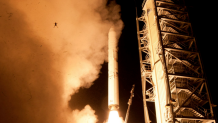A rocket wasn't the only thing blasted into the air during last week's NASA launch on Virginia's Eastern Shore.
A frog went, too -- and the bizarre moment was captured in a photograph taken by a remote NASA camera.
Granted, that frog only went a few feet into the air, while the unmanned LADEE spacecraft is going all 238,850 miles to the moon.
Wallops Island spokesperson Jeremy Eggers confirmed to NBC Washington that the image is legitimate and was not altered in any way.
Get Southern California news, weather forecasts and entertainment stories to your inbox. Sign up for NBC LA newsletters.
The image was taken by a still camera triggered by sound.
"It's an authentic photo -- there were about eight or nine frames in the sequence; however, this is the only one showing the image of a frog," Eggers said via email.
Still skeptical? The frog appears larger than viewers might expect because it was closer to the camera than the rocket.
U.S. & World
News from around the country and around the globe
Chris Perry, who set up the camera, estimates it was about 150 feet from the rocket. The frog was probably only about 50 feet from the camera, he said.
But the one question everyone wants to know is: What was the fate of that frog?
"LADEE is doing well right now, but we are not certain of the frog's fate," Eggers said.
The Lunar Atmosphere and Dust Environment Explorer (LADEE) -- which lifted off at 11:27 p.m. Friday aboard a Minotaur V rocket -- is set to reach the moon Oct. 6.
Once there, the spacecraft will orbit for a few months, analyzing lunar dust and the atmosphere, according to the Associated Press.
While this wasn't the first time NASA caught something like this on camera, it's the first time at Wallops Island.
"Our photo archive contains launch sequence photos from every launch, and none that I’ve seen so far has shown us anything like this before," Perry said via email. "Definitely a surprise to us (and a little sad)."
The image garnered plenty of reaction on NBC Washington's Facebook page.
"Ground Control to Major Frog," quipped Michael Kuzniar.
Full image courtesy of NASA below:

ALSO SEE:



